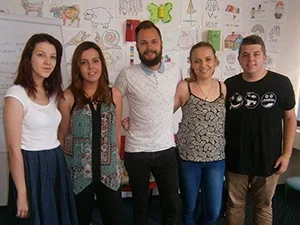Our Way Is Peace
This summer five Bennington students from Bosnia explored the intersections between peacebuilding and theater through their work with The Center for Peacebuilding (CIM) in Sanski Most, Bosnia and Herzegovina. Now, they are bringing what they’ve learned back to Bennington. They will present their work at the Peacebuilding in Action panel on October 1 at the Center for the Advancement of Public Actions (CAPA).

The students, Dado Čobo ’17, Nejla Katica ’18, Ajsa Udovcic ’18, Amina Hodžić ’18, and Inas Gačanin ’19, led activities at CIM that fulfilled the organization's mission of fostering "the core concepts of mutual listening, understanding, and compassion through (re)building relationships.”
The wheels for this summer’s work were set in motion last summer, when faculty member Mirka Prazak, an anthropologist whose work focuses on economic development and cultural change in East Africa, attended a colloquy at Keene State College about the nation of Bosnia and Herzegovina twenty years after the signing of the Dayton Accords, galvanized by the negative prognosis for a lasting peace. She met with Bosnian students and invited them to become a part of developing an idea for peacebuilding.
“The students were creative, committed, and eager to return to their country to make a difference” she said. "The project gives students who want to see positive social development in their countries of origin an incredible opportunity to become the agents of change,” Prazak continued. “Especially combined with or augmented by Field Work Term internships in peacebuilding organizations, they are able to develop skills in real life situations.”
Inside the Center
The Center for Peacebuilding, which opened in 2004, was founded on the fault lines of ethnic conflict. CIM’s mission is to provide “a safe space for constructive interethnic and religious dialogue” and to “train individuals in practical conflict resolution techniques, equipping them with skills to respond to conflict.”
At CIM, Čobo and his peers explored issues of identity and humanity through performative exercises. One included masks, and as Čobo explained, “We have talked about [the] many masks of ‘composure’ all of us wear on a daily basis in order to protect ourselves from judgement or simply to feel safe.”
When asked how his work taught peacebuilding skills, he clarified further:
The work I have done during the workshops was not intended to teach the students peacebuilding skills directly, but rather [to show] that through art and artistic expression we can connect with each other and free ourselves of prejudices and judgements that have grown in our community for many years during and after the war. The mask exercises [for example] allowed the participants to safely look at personal barriers that keep them from being in community, with themselves, or with others.
Back to Bennington
The work that Bennington students have done at CIM is complemented by and tied into Prazak’s Fall 2016 class Beginning Peacebuilding, which focuses on exploring issues and concepts of building positive relationships to direct social change, and on gathering information about “the types of peacebuilding programs and initiatives….which are effective, and which aim at engaging young people to become peacebuilders in the post-conflict societies they come from and wish to return to.”
Her work in this area, together with that of CAPA director Susan Sgorbati, also includes a Peacebuilding In Action think tank which will be held on October 1, 2016 in CAPA to discuss the aims, possibilities, and challenges of developing a peacebuilding program at Bennington College.